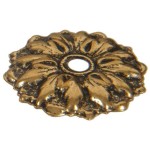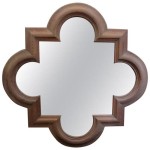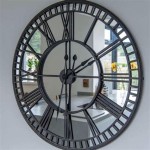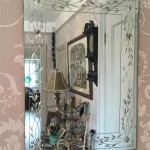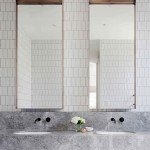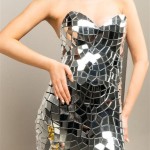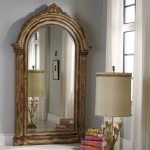How to Hang a Frameless Mirror
Frameless mirrors offer a sleek, modern aesthetic, seamlessly integrating into various interior design styles. However, their lack of a traditional frame presents unique challenges when it comes to hanging. This article provides a comprehensive guide to securely and effectively mounting a frameless mirror on the wall.
Before initiating the hanging process, careful planning and preparation are essential. Begin by accurately measuring the mirror's dimensions. This measurement will inform the selection of appropriate hanging hardware and the placement on the wall. Consider the desired height and ensure it aligns with the surrounding furniture and wall space.
Choosing the correct hanging hardware is paramount for the safety and stability of the frameless mirror. Several options are available, each suited to different mirror sizes and wall types. For lighter mirrors, adhesive mirror mounting clips offer a simple and straightforward solution. These clips adhere directly to the back of the mirror and the wall, providing a secure hold. Ensure the adhesive is compatible with both the mirror's backing and the wall material.
Heavier or larger frameless mirrors require more robust hanging methods. J-channels or Z-clips offer a secure and discreet solution. J-channels are metal tracks installed on the wall, into which the bottom edge of the mirror slides. Z-clips consist of two interlocking metal pieces, one attached to the wall and the other to the back of the mirror. These clips provide a strong grip and are suitable for mirrors of considerable weight.
Once the appropriate hardware is selected, the next step involves marking the desired location on the wall. Use a pencil and a level to ensure accurate placement and a straight hanging line. For J-channels, measure the distance from the top edge of the mirror to the top edge of the J-channel and transfer this measurement to the wall. For Z-clips, mark the locations of the wall-mounted clips according to the manufacturer's instructions, ensuring proper spacing and alignment.
Installation procedures vary based on the chosen hanging hardware. For adhesive clips, thoroughly clean both the wall and the back of the mirror with a suitable cleaning agent to ensure optimal adhesion. Peel off the protective backing from the adhesive strips and carefully affix the clips to the designated locations. Allow the adhesive to cure completely before mounting the mirror.
Installing J-channels requires securing the metal tracks to the wall using appropriate screws and wall anchors. Ensure the screws are driven flush with the surface of the track to prevent interference with the mirror. Once the J-channels are securely installed, carefully slide the bottom edge of the mirror into the track.
For Z-clips, attach the wall-mounted portion of the clips to the marked locations using appropriate screws and wall anchors. Then, attach the corresponding clips to the back of the mirror, ensuring proper alignment. Carefully interlock the two sets of clips to secure the mirror to the wall.
Regardless of the chosen hanging method, using a level throughout the installation process is crucial. This ensures the mirror hangs straight and prevents any tilting or unevenness. Periodically check the level throughout the process, making adjustments as needed.
Different wall materials necessitate specific considerations during the installation process. Drywall typically requires the use of wall anchors to provide adequate support, especially for heavier mirrors. For masonry walls, specialized masonry anchors and drill bits are necessary. Consult the hardware manufacturer's instructions for specific recommendations based on the wall type.
Safety precautions are paramount throughout the entire hanging process. Always wear appropriate safety glasses when drilling into walls to protect your eyes from debris. Handle the mirror with care to avoid dropping or damaging it. If working with a particularly large or heavy mirror, enlist the assistance of another person to ensure safe handling and installation.
After the mirror is securely mounted, consider applying a thin bead of neutral-cure silicone sealant along the edges where the mirror meets the wall. This provides added security and prevents moisture from seeping behind the mirror, which could potentially damage the wall or the mirror's backing.
Regular maintenance helps preserve the appearance and longevity of the frameless mirror. Clean the mirror surface regularly with a suitable glass cleaner to remove smudges and fingerprints. Inspect the hanging hardware periodically to ensure it remains secure and undamaged. If any issues are detected, address them promptly to prevent potential damage or hazards.
By following these detailed instructions and taking necessary precautions, hanging a frameless mirror can be accomplished safely and effectively, enhancing the aesthetic appeal of any space.

How To Install A Mirror Without Frame Merrypad
:strip_icc()/DesireeBurnsInteriors1-f76d25cad90041c88fbae4a7dc10aab4.jpg?strip=all)
2 Simple Ways To Hang A Frameless Mirror

How To Hang A Frameless Mirror On The Wall With Pictures

How To Install A Mirror Without Frame Merrypad

How To Hang A Frameless Mirror On The Wall With Pictures

How To Hang A Frameless Mirror On Wall E Architect

How To Hang A Frameless Mirror June 2024 Your Guide Hanging

How To Hang A Hanging Mirror Without Accompanying Hardware

Oval Frameless Wall Mirror Installation Fab Glass And

How To Hang A Heavy Mirror At Home

